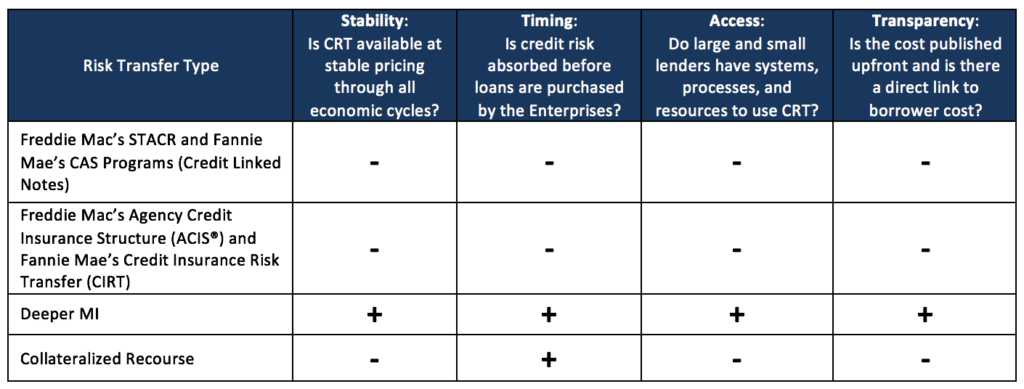Luisa De Gaetano Polverosi
Associate Managing Director
Moody’s Investor Service
7 World Trade Center
250 Greenwich Street
New York, NY 10007
Dear Ms. De Gaetano Polverosi:
U.S. Mortgage Insurers (USMI) welcomes the opportunity to provide comments on the “Proposed Update to Moody’s Approach to Rating US Prime RMBS”. Our members are supportive of the proposed update to Moody’s methodology, and view this update as a necessary step toward examining and updating various models, and also as a step toward prudently revitalizing the private securitization market for Residential Mortgage-Backed Securities (RMBS). We applaud the recognition that the value of private mortgage insurance (MI) extends beyond the government-sponsored enterprise (GSE) segment of the housing finance system and we believe that RMBS investors can greatly benefit from the loss severity reduction resulting from MI.
Of particular interest to our members is the proposed update to the evaluation of private MI. Lenders originating mortgages with loan-to-value (LTV) ratios above 80% typically obtain MI to maintain maximum flexibility for secondary market execution. Currently, however, the lack of credit for MI in the rating determination provides little incentive for these mortgages to be included in RMBS structures and transactions. The proposed changes to the methodology address this issue and lenders will no longer be disincentivized to direct mortgages with LTVs above 80% to the RMBS market, thus increasing access to liquidity in support of homeownership and offering investors more choices with regard to taking credit risk in this vital segment of the mortgage market.
Our members appreciate that the proposed update to Moody’s methodology has been the result of an investment of considerable time and effort in data analysis, as well as careful attention to the development of the mortgage lending landscape. While the proposal as published is an improvement, in the spirit of mutually beneficial ongoing dialogue, we would like to offer some commentary on the proposed methodology. Generally speaking, we feel that additional transparency, particularly more details around the benefits of MI, the proposed changes to rejection rates, and Moody’s methodology of determining maximum insurance payout and allocation based on the insurer’s rating, would be highly beneficial to market participants and enable more detailed analysis of the proposal, in addition to some minor recommended adjustments.
Rejection Rate Assumptions
Looking at the proposed rejection rates, a more detailed representation of the slope and/or shape of the line between the Baseline Assumption and Aaa Assumption would be useful, as well as more details surrounding the Aaa Assumption’s rejection rate range of 5-15% in the absence of a GSE backstop. In additional, the variability of the Aaa Assumption should include disclosures of all the factors that can drive a final determination.
We would also encourage the rejection rate assumptions to reflect MIs’ updated Master Policies which increased clarity on terms and streamlined the payment of claims to ensure that MI coverage results in timely, consistent, and accurate policy and claim administration. The proposed update’s rejection rate assumptions should account for the imbedded Rescission Relief (contractual circumstances under which an MI waives it rights to rescind coverage on a mortgage) applicable to the loans in a specific transaction. Mortgages that are already subject to Rescission Relief should have lower assumed rejection rates, and the various milestones regarding Rescission Relief should also be considered in the overall lifetime projections. Our member companies are more than willing to provide detailed information on Rescission Relief to Moody’s to assist with the refinement of implementation of the rejection rate assumptions.
Further, the proposed update to the rating methodology should reflect overall improvements in mortgage originators’ underwriting standards, as well as the MI industry’s new capital framework that is driven by the GSEs’ Private Mortgage Insurer Eligibility Requirements (PMIERs). All MI companies comply with PMIERs’ stringent capital and operational requirements and the industry has nearly doubled its pre-crisis capital, an indication of the industry’s strength and that MI on loans included in securitizations should improve credit enhancement levels in rated RMBS transactions.
The rejection rate haircut should also reflect the Representations & Warranties of a particular transaction and encourage stronger language by providing a benefit to RMBS issuers that provide investors with an extra layer of protection. There have been significant improvements to lenders’ underwriting practices, including the use of independent validation sources, over the last several years that would serve to reduce the overall rejection rates and improve credit enhancement levels, and should therefore be considered for loans that will be repurchased due to loan manufacturing defects or where the trust will be made whole due to servicing defects. Lastly, with regards to the differential treatment of the GSE backstop, USMI encourages Moody’s to consider broadening that category to create a level playing field by including additional types of credit enhancement backstops from a variety of counterparties that would supplement private MI’s credit risk protection.
Maximum Insurance Payout and Allocation
The proposed update includes analysis of expected losses but currently lacks visibility into the benefit of MI as it relates to the Moody’s Individual Loan Analysis credit enhancement (MILAN CE) framework. We would like to request that Moody’s disclose detailed methodology regarding treatment of MI in the MILAN framework. In practice, it is critical that a RMBS issuer be able to quantify the benefit of MI with a certain insurer rating in each of the rating scenarios. Therefore, we believe the RMBS market will greatly benefit from Moody’s publishing the Idealized Expected Loss Table which demonstrates the conversion from non-rejected insured losses to idealized losses in correspondence to the insurance rating of MI in each loss scenario. Without seeing the Idealized Expected Loss Table, it is difficult to comment on this specific component of the proposed methodology update, but there are a couple of general comments related to this element of the rating methodology we would like to offer.
The first is that since the rating of private MIs depends on many factors beyond their capital adequacy, it is possible that purely using an overall company rating may be overly conservative. For examples, ratings of private MIs may not fully reflect the benefit of credit risk transfer programs the MI industry executes with global capital markets and reinsurers, which have transformed the MI business model from “buy-and-hold” to “buy-manage-distribute” and significantly strengthen MIs’ capital positions and claims paying ability during stress periods. While the insurer rating may be reflective as an overall measure of counterparty risk, the incorporation of non-claims payment factors means that items not related to the ability to pay all claims are taken into consideration. It would be very helpful to have access to MI rating sensitivity analysis, as well as loss scenarios that inform the proposed methodology updates.
The second comment is that we would like to understand how the maximum insurance payout (MIP) plateaus and how the state-based insurance regulatory framework has been reflected. Of the private MI companies that ceased writing new business during the financial crisis approximately a decade ago, their cash payouts currently range from approximately 75% to 100%, with the remainder being deferred payment obligations (DPO) – facts that support very high MIP assumptions.
Conclusion
Thank you again for the opportunity to comment on the “Proposed Update to Moody’s Approach to Rating US Prime RMBS.” Our members appreciate the data-driven analysis and proposed update, and look forward to continuing a mutually beneficial dialogue, including on the topic of recognition of the value of private MI. This important shift can help promote new interest in private label RMBS, as lenders will have increased secondary market execution flexibility when it comes to their insured mortgage production. By providing an avenue for mortgages with private MI to contribute to the supply of collateral for RMBS, we will see improved liquidity for lenders and an expansion of mortgage credit investment opportunities for private capital investors.
Questions or requests for additional information may be directed to Lindsey Johnson, President of USMI, at ljohnson@usmi.org or 202-280-1820.
Sincerely,

Lindsey D. Johnson
President
U.S. Mortgage Insurers














